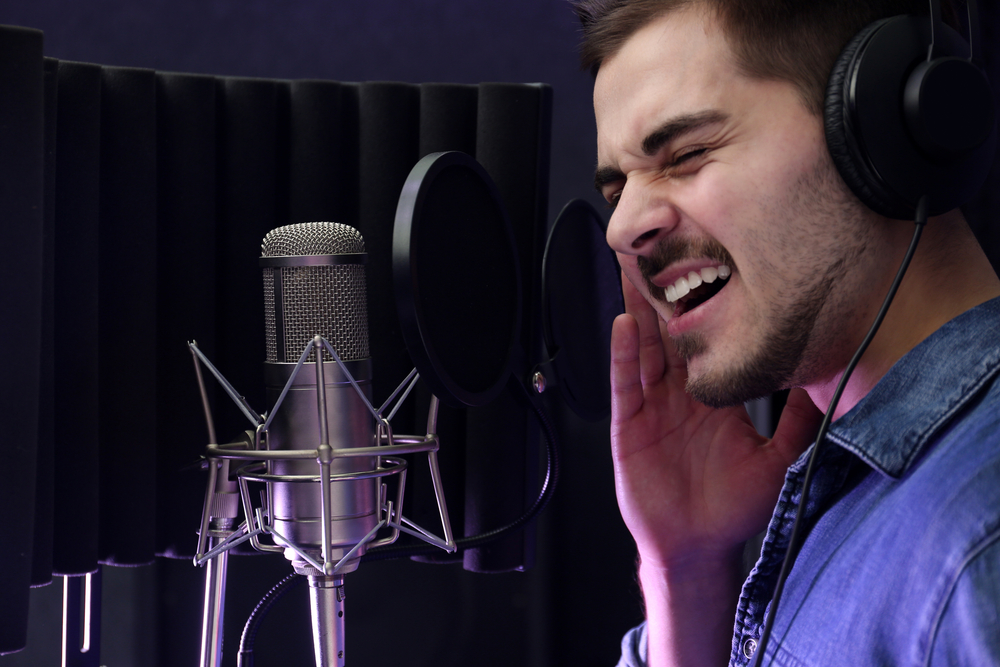The world is full of diverse voices that complement each other in unique ways. They have different qualities, capabilities and roles. In this article, we will explore the distinctions that envelop the world of male singing, namely, what is it that separates baritones and basses. Beyond the obvious contrast in vocal ranges, understanding the nuances of these two voice types is crucial for performers as well as audiences who want to reach into the depths of the vocal arts.
Whether you’re a singer, a fan of opera, or simply curious about the world of vocal music, this exploration will shed light on the captivating world of male voices and their remarkable diversity.

What is a Vocal Range?
Your vocal range is the set of notes your voice can produce from the very highest to the very lowest. Basically, it’s everything you can sing with good tone quality. While low notes are produced by loose, thick vocal cords, high notes are sung by stretching and thinning out the vocal cords. However….(I love that word, because it means we’re about to discover something new), it is not merely the stretching and thinning of the vocal cords that increases the range of the singing voice, but it is another mechanism called ‘dampening’ of the vocal cords. Regardless of voice type, a singer can lose excess vocal weight, through this technique which actually zips up the voice cords, thus shortening the vibrating surface of the vocal cords and increasing the range—regardless of the voice classification.
According to tradition, we are told that the lowest notes of a singing voice can usually be extended a few semitones with “proper” training and exercises. But, the highest portion of the range can often be stretched quite a bit further!
However…..😉 This is according to the ‘ostensibly’ or ‘supposedly’ ‘proper training’ in the universities. The coaches in my Nashville studio, and my associate teachers around the world, have typically been able add at least a half octave to both low and high ends of the voice.
Tradition doesn’t have to mean ‘stagnant’ or ‘limiting’ as was explained earlier in the ideology of dampening the cords vs stretching them.
Obviously, a male voice type won’t often compete (though there are exceptions) with a typical soprano voice as far as the upper register, but not all voice types are meant to sing the exact same ranges. That’s why we need all voices covering a variety of ranges and lending colorful diversity to the musical landscape.
Why is it Important to Find Your Vocal Range?
There are so many reasons why knowing your vocal range is key to your growth as a singer. Here is the breakdown:
- Song Selection: Knowing the limits of your voice and what your voice type is can help you with your song selection. Choosing songs written or sung by artists can help you have confidence that you can hit the notes accurately while protecting your voice from unnecessary strain.
- Avoid Strain and Injury: We want to grow our ranges and strengthen our voices, but the way to do that is not by straining your voice. Singing outside your range without proper instruction can and will cause strain on your vocal cords which will likely lead to injury. Knowing your range helps you avoid pushing your voice to the extremes and reducing the risk of vocal problems like nodules or hoarseness.
- Better Performance: When you are within your range, you can have the confidence that each note is well within your capabilities. When you perform, your level of confidence comes through. The last thing we want is for your expression of the song to be hampered because you’re not confident in the notes.
- Vocal Development: Knowing where to begin gives you direction. As stated earlier, stretching your voice is a good thing when you have the proper training. A vocalist can increase their range by following the correct regimes, but not without understanding their range first. Not only does it help with your range, but it also helps with your pursuit of proper technique, tone quality, volume control and so much more.
- Auditioning and Collaboration: You want to be at your best when auditioning, so this goes back to picking music that fits your voice. Choose something that you know plays to your strengths. As far as collaborations go, knowing the voice types of everyone involved will help with communication and choosing the right partners. Furthermore, knowing vocal transition points or ‘bridges’ that effect or change basic vocal timbre, is great to know. A Male singer can collaborate with multiple female voice types as long as there are shared qualities in vocal timbre.
- Customization: Working with a vocal teacher will quickly make you realize how customized lessons are. Knowing the singer’s voice type is how the teacher creates exercises and lessons to work with your unique vocal range.
- Recording and Studio Work: Classical music is a little less flexible than contemporary music, but in the recording studio, it’s important to know your range so that you can select the proper key for the song and track ahead of time.
- Vocal Health: As already mentioned, keeping your voice healthy is crucial. Staying within your range (unless otherwise instructed for growth) is important for not straining your voice unnecessarily.
- Personal Growth: Being self-aware and realistic about your abilities allows you to set attainable goals and be proud when you hit them instead of being frustrated by a voice you haven’t yet discovered.
- Artistic Expression: Understanding your vocal range gives you the freedom to be expressive. You can make choices that suit your voice and style while exploring different vocal techniques and genres within your comfort zone. Always remember this… if you’re not comfortable, you won’t be confident!

What is the Baritone Vocal Range?
The typical baritone range is F2–A4.
The baritone may be the most common of the male voice types, but it is far from ordinary. The vocal weight and power that this voice type wields is always pleasant to listen to.
The baritone is often used in opera for the roles of generals and noblemen: men of great power. Familiar roles include Don Giovanni, Figaro, and Count Almaviva, among others.
The reason a lot of baritones aren’t very knowledgeable about their voice type is that it’s not covered in choir. Baritones either sing with the tenors or basses and the range isn’t often discussed further.
Baritones are right in the middle of basses and tenors, often not being able to reach as high as a true tenor voice or as low as a bass. However….there are anomalies and exceptions. I’ve trained baritones who can sing comfortably above high C, or C5. Others have been able to sing to the bottom of the piano. And a few extraordinary singers can do both.
What are the Subcategories of the Baritone Voice?
1. Baryton-Martin
The range of a Baryton-Martin Baritone is C3 to A4
This kind of baritone is light, almost tenor-like, in its tone quality. It’s typically only seen in French repertoire and was, in fact, named after the French singer, Jean-Blaise Martin.
Baryton-Martin baritones possess a warm and rich timbre in their lower notes, similar to traditional baritones, but they also exhibit a light and agile quality in their higher vocal registers that is better known as a quality of tenors. This versatility makes them well-suited for a wide range of operatic and vocal repertoire.
2. Coloratura Baritone
The range of a Coloratura Baritone is G2 to C5.
The term “Coloratura” is one that means “to color” or “coloring.” Basically, it describes a melody that requires runs, wide leaps, trills, and/or other virtuosic ornaments. The singers of these parts are also called coloratura. These roles are often found in opera from the 18th and 19th centuries.
This voice type is a relatively rare and specialized type of baritone voice characterized by its agility, flexibility, and the ability to perform coloratura passages and ornamentations typically associated with higher voices, such as sopranos and mezzo-sopranos. The lightness and ease with which these baritones tackle these passages, combined with the rich timbre of a baritone voice is truly a captivating thing to hear.
3. Heldenbaritone (AKA Bass-Baritone)
The range of a Heldenbaritone is, roughly, F2 to F4.
Heldenbaritones are voices primarily associated with the operatic works of Richard Wagner, a renowned German composer. The term “Heldenbaritone” translates to “heroic baritone” in English, reflecting the specific dramatic and heroic roles that these baritones typically portray in Wagner’s operas. The voices are powerful, commanding, and dramatic, drawing out emotion with bold strength.

4. Kavalier Baritone
The range of a Kavalier baritone is A2 to G4
This voice type is a subcategory of the Lyric Baritone, though it’s more powerful. It’s usually used in the German classification system and was favored by composers such as Strauss, Verdi, and Tchaikovsky to provide variety in the lower register of their operas. Popular operatic roles for the Kavalierbaritone included Escamillo in Carmen, Count in Capriccio, and Ford in Falstaff.
The Kavalier baritone is required to have a strong, commanding voice, even in those higher registers. That’s where a lot of the variety comes from, so strength in that area is vital to having the correct tone.
5. Verdi Baritone
The range of a Verdi Baritone is G2 to B4.
What makes up a true Verdi Baritone? It isn’t just the ability to hit certain notes. It also includes the iconically big, rich, ringing high notes. The roles that these baritones sing require stamina in a high range and often portray complex characters such as Macbeth. Baritones of this type, looking to venture into opera, should probably have a healthy dose of charisma packed in their bags!
6. Baryton-Noble
The range of a Baryton-Nobel is A3 to B4
“Baryton-Nobel” is French for “Nobel Baritone.” These voice types are characterized by their noble bearing, smooth vocalization, and forceful emphasis. These singers often play counts, princes, kings, or even gods. For example, Jupiter in Offenbach’s Orpheus in the Underworld.
7. Dramatic Baritone
The range of a Dramatic Baritone is G2 to G4.
The term “dramatic,” when referring to a voice, is used when a voice has an unusually loud volume without too much effort. These voices are able to sing over heavy orchestration such as you will find written by Verdi or Wagner. This term is not meant to apply to the theatrical performance.
These voices are richer, fuller, and sometimes harsher than some other baritones, and they also tend to have a darker quality. They roughly correspond to the Heldenbaritone, which we discussed earlier in the article.

What is the Bass Vocal Range?
The broad-brush answer to this question is that most bass voices can reach somewhere within the range of E2 to E4.
The bass voice type is the lowest male vocal range. They’re known for seemingly impossible, deep, and resonant tones. They are often associated with roles of authority, villains, or wise and experienced characters in opera, classical music, and musical theater because of their bone-chilling depth.
What are the Subcategories of the Bass Voice?
1. Basso Profondo
The range of a Basso Profondo is E1 to E3.
Basso Profondo voices are relatively rare. The Italian term that makes up their name means “deep bass” because of the incredible range downward. Their extreme depth allows them to take on roles that require a profound and commanding vocal presence in opera, choral music, and other vocal genres. They are often associated with roles of mythical or otherworldly characters due to the sheer depth and power of their vocal range.
Widely recognized opera roles for Basso Profondo singers include Hagen from Wagner’s Die Götterdämmerung, Commendatore from Mozart’s Don Giovanni, Grand Inquisitor from Verdi’s Don Carlo, and the Viking Guest from Rimsky-Korsakov’s Sadko.

2. Basso Buffo
The range of the Basso Buffo is E2 to F4.
A Basso Buffo is a specific type of bass voice found in opera and operatic comedic roles. The term “buffo” comes from the Italian word for “funny” or “comic.” Basso Buffos are known for their ability to excel in comic and character roles. It’s these roles that often end up providing humor and comic relief in operatic performances.
Basso Buffo singers need vocal agility, expressive acting, and comedic timing. They often play men who were respected in society and have fallen, or madmen. Famous Basso Buffo roles include Dr. Bartolo in “The Barber of Seville” by Rossini and Don Pasquale in Donizetti’s “Don Pasquale.” These characters are known for their humorous antics, witty exchanges, and ability to entertain the audience with their comedic performances.
3. Bel Canto Bass
The range of a Bel Canto Bass is C2 to C4.
In Italian, the words “bel canto” mean “beautiful singing.” These voices are known for their beautiful tones, expressive phrasing, and vocal agility. They encompass a wide range of techniques and ornamentation. Bel Canto Bass singers take the high-flying coloratura characteristics usually reserved for sopranos and tenors and highlight the depth and power of a bass voice.
4. Dramatic Bass
The range of a Dramatic Bass is from D2 to D4.
As we discussed a few paragraphs ago with the baritones, “dramatic” when applied to voice types is a very specific word. It’s referring to an especially loud voice that doesn’t have to force itself.
Dramatic basses are known for their greater vocal power and intensity, making them suitable for very dramatic and emotionally charged roles in opera and other vocal performances.
5. Bass Cantante
The range of a Bass Cantante is E2 to E4.
While this bass voice type may share the standard bass voice range, it is set apart by its unique ability in the upper range.
“Bass Cantante” is an Italian term used in opera to describe a bass singer with a lyrical voice. This voice type is characterized by its ability to deliver melodic and lyrical lines with smoothness and beauty; akin to the qualities found in other lyrical voice types such as tenors and sopranos.
What is the Difference Between Baritone and Bass Vocal Ranges?
Basses and baritones are two essential male voice types in the world of music. Though they are both necessary and they differ greatly in their vocal characteristics, ranges, and the roles they play in opera, choral music, theater, and other genres. Basses are often cast in roles of authority, wisdom, and command, such as kings, priests, and villains. Conversely, baritones have slightly higher ranges and are cast in a variety of roles from romantic interests to comedic relief.
One of the primary distinctions lies in their vocal ranges. Basses are characterized by their deep and resonant voices ranging from E2 to E4 with some exceptions based on the subcategory. Baritones reach higher, usually extending from an A2 all the way up to an A4 or even higher. They tend to have warmer, more versatile timbre that can more easily convey a broad range of emotions.
Speaking of timbre, bass voices are easily recognized by the powerful and dark qualities of their voice. These voices are often associated with depth and gravitas, hence the roles they are often asked to portray. Baritones like to keep the scene warm and comfortable. That’s not to say that they cannot express something grave and serious, but they have some room to explore the emotional landscape in a way that some basses cannot.
Conclusion
Baritone and bass are two of the male voice types. There are many differences between the two and many subcategories of each. Bass is the lowest male range while baritone lies between tenor and bass, bridging the gap.
These two voice types differ in the roles they play in opera, choir, theater, pop, and any other kind of music because they are distinct and crucial to the musical world. Without this plunge into the depths of vocal ranges, we would be lacking so much complexity in music. The world is made up of highs and lows and we need all of it if we’re going to attempt portraying something realistic of life.
One voice type is not more important than the other, nor more beautiful. However, both voices have their strengths and their weaknesses. Every singer has the potential to reach incredible heights (metaphorically speaking) and make astounding music that will move audiences, no matter the category or subcategory he or she falls into.
If singing is your passion and you want to train with a world class, Singing Success certified coach, please contact us at
support@singingsuccess.com
or call us at
615-866-1099
or book online at






